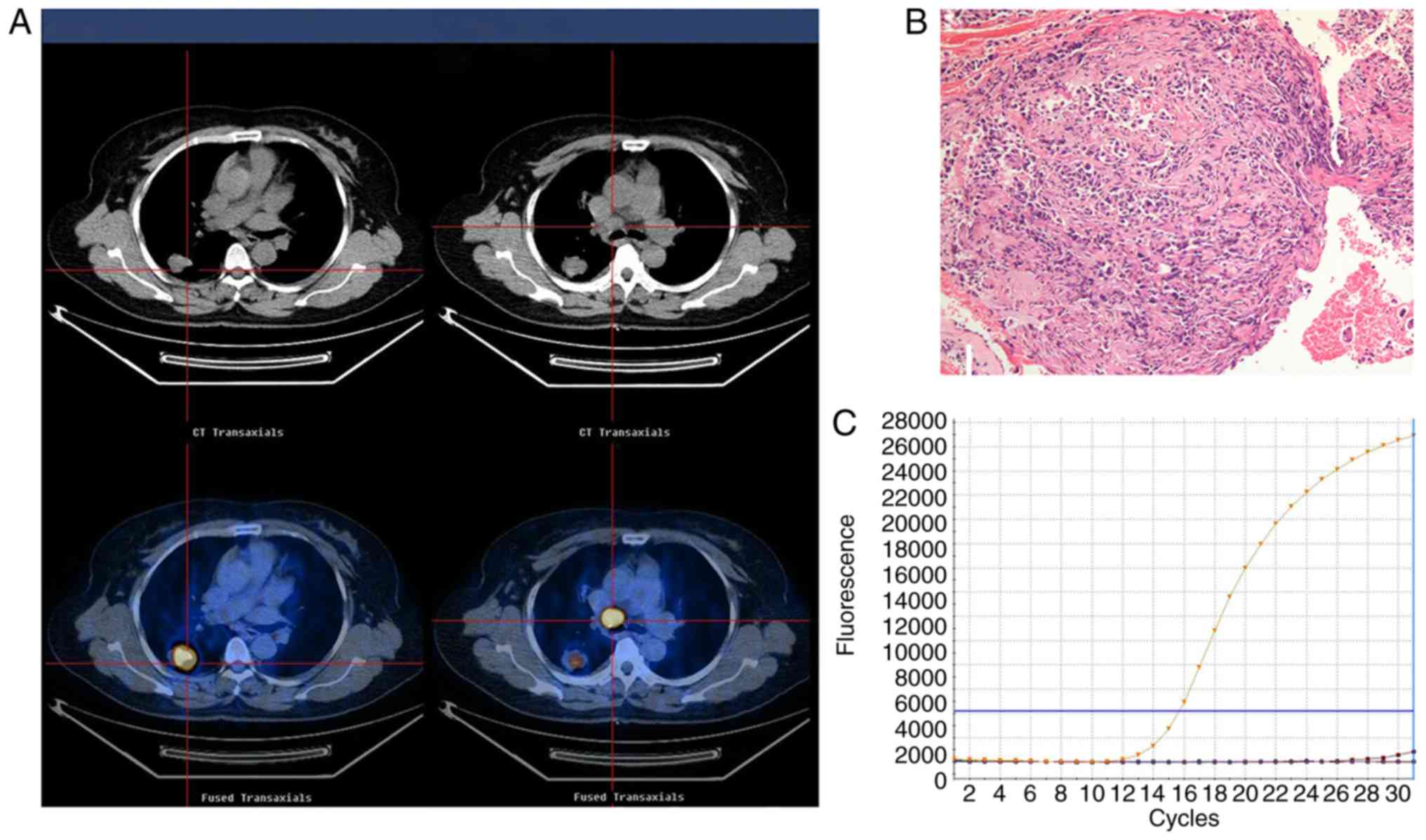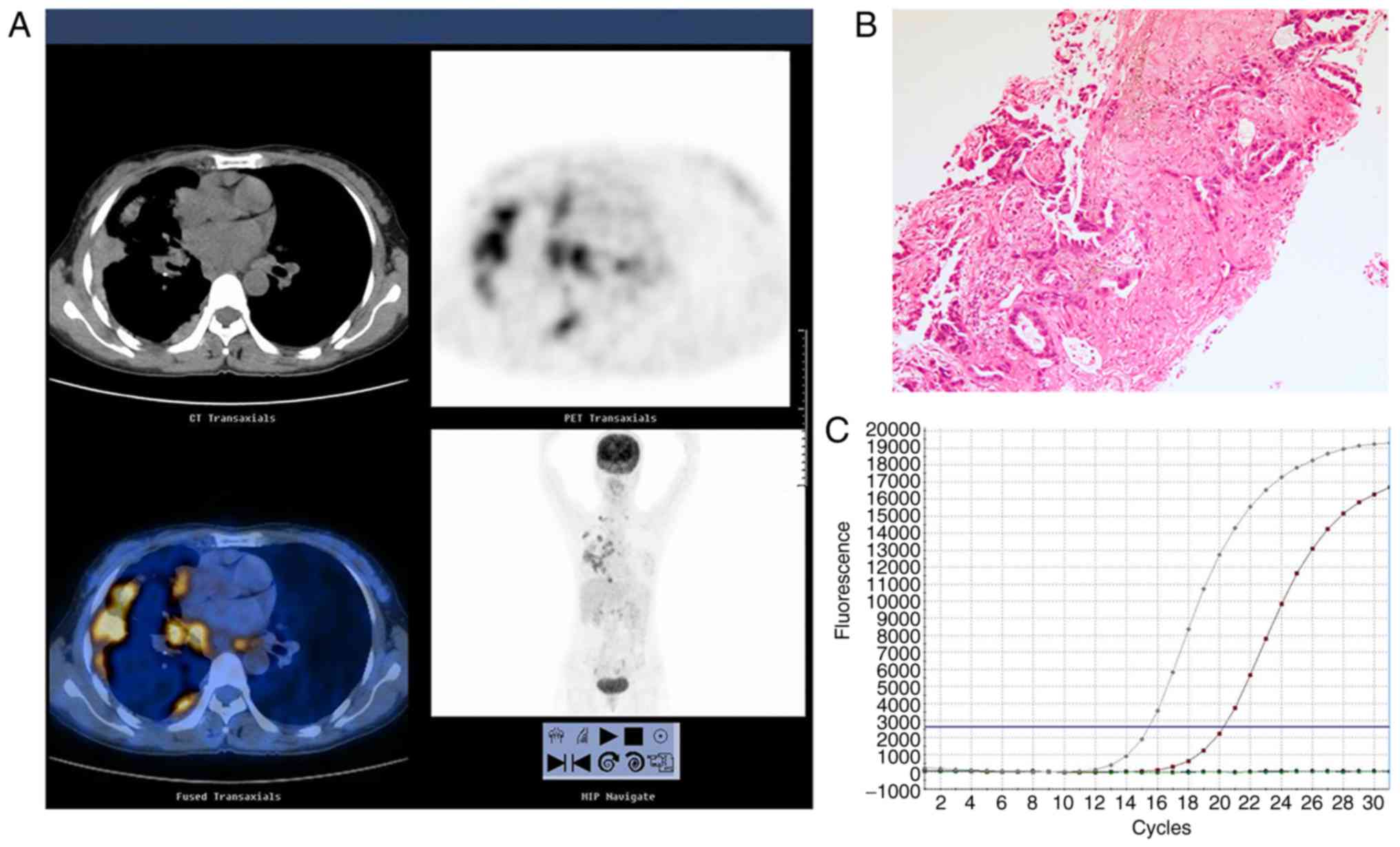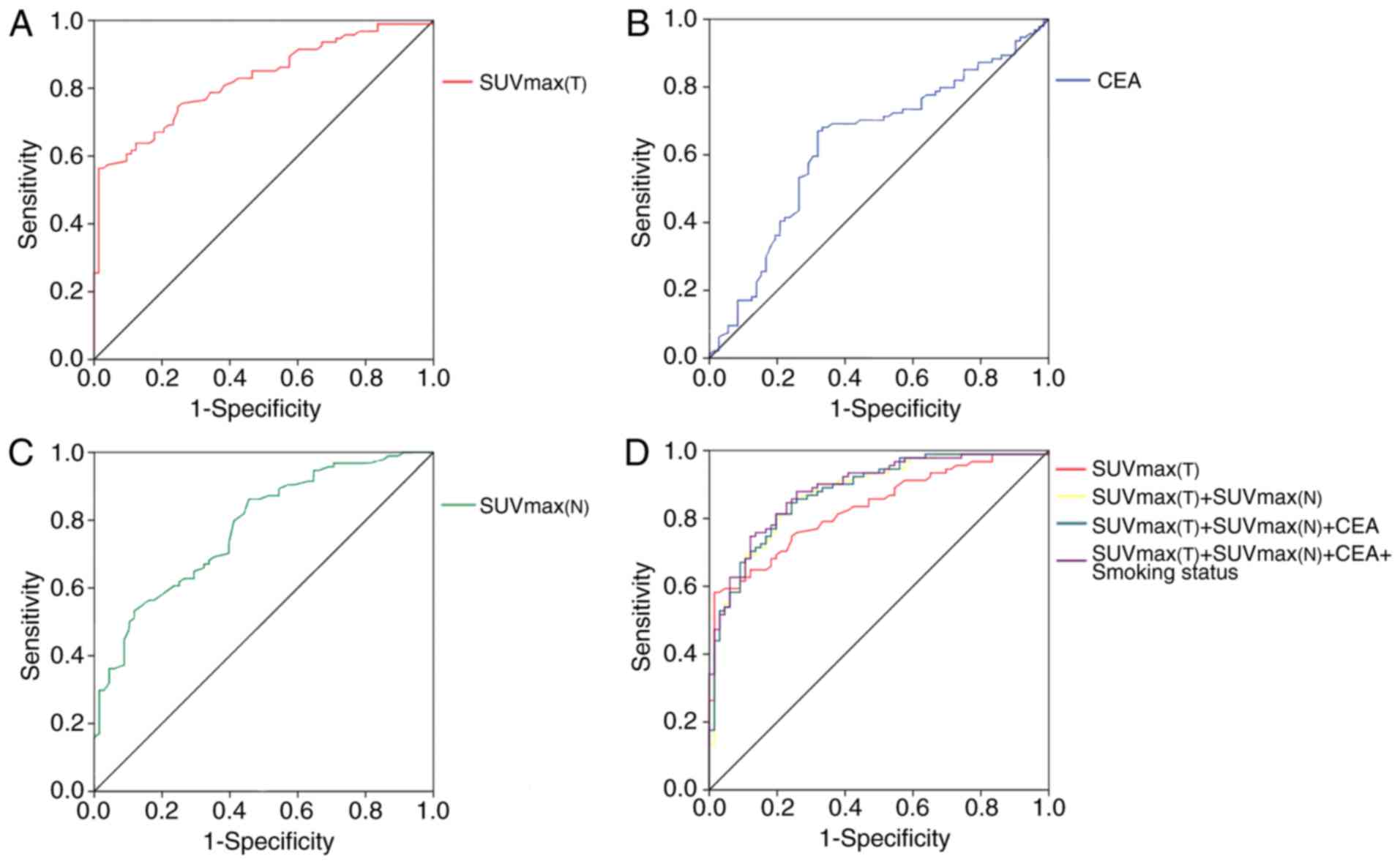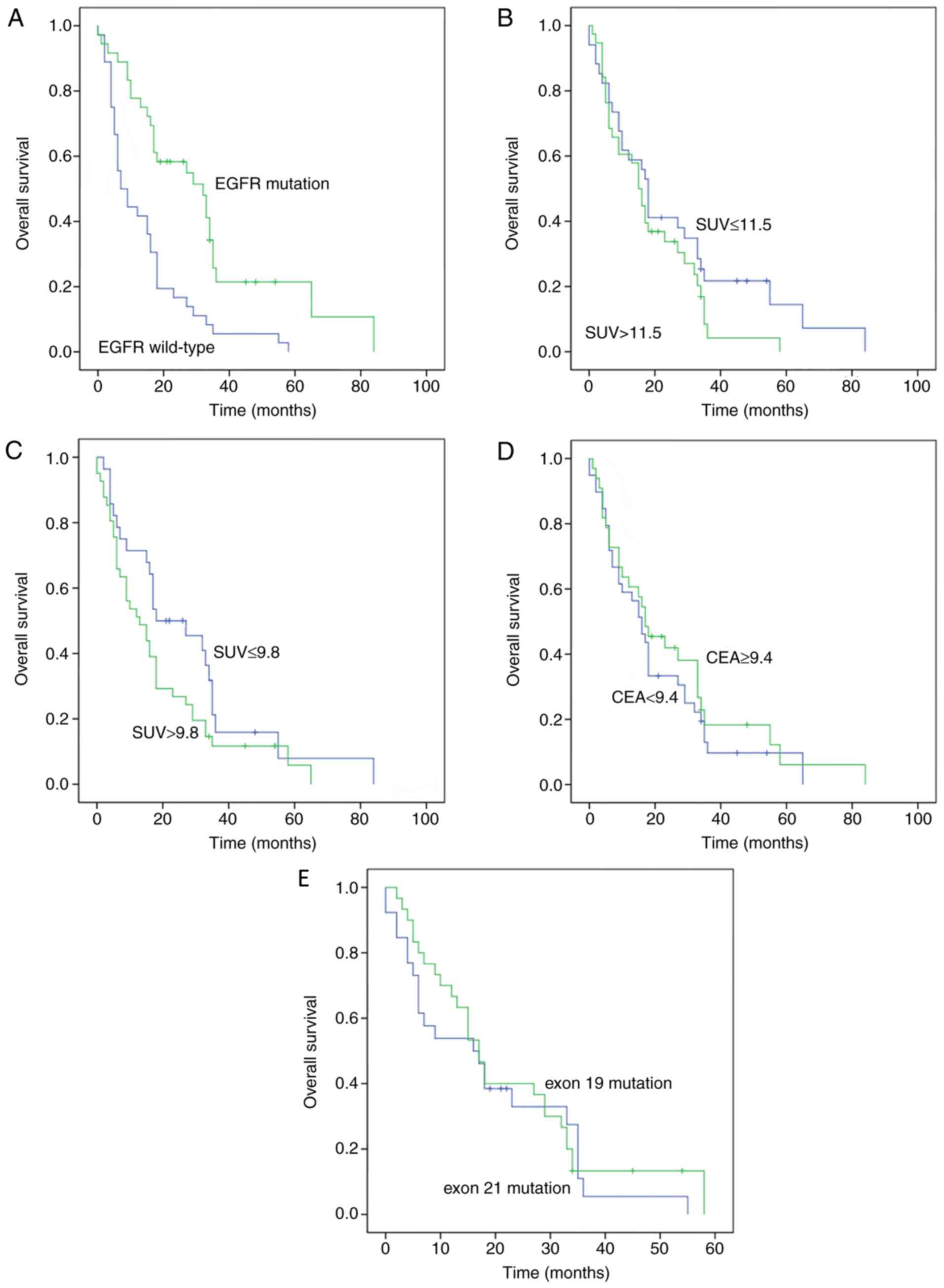|
1
|
Bray F, Ferlay J, Soerjomataram I, Siegel
RL, Torre LA and Jemal A: Global cancer statistics 2018: GLOBOCAN
estimates of incidence and mortality worldwide for 36 cancers in
185 countries. CA Cancer J Clin. 68:394–424. 2018. View Article : Google Scholar : PubMed/NCBI
|
|
2
|
Chen W, Zheng R, Zeng H and Zhang S:
Epidemiology of lung cancer in China. Thorac Cancer. 6:209–215.
2015. View Article : Google Scholar : PubMed/NCBI
|
|
3
|
Ettinger DS, Akerley W, Bepler G, Chang A,
Cheney RT, Chirieac LR, D'Amico TA, Demmy TL, Feigenberg SJ, Figlin
RA, et al: Non-small cell lung cancer. J Natl Compr Canc Netw.
6:228–269. 2008. View Article : Google Scholar : PubMed/NCBI
|
|
4
|
Molina JR, Yang P, Cassivi SD, Schild SE
and Adjei AA: Non-small cell lung cancer: Epidemiology, risk
factors, treatment, and survivorship. Mayo Clin Proc. 83:584–594.
2008. View Article : Google Scholar : PubMed/NCBI
|
|
5
|
Schiller JH, Harrington D, Belani CP,
Langer C, Sandler A, Krook J, Zhu J and Johnson DH; Eastern
Cooperative Oncology Group, : Comparison of four chemotherapy
regimens for advanced non-small-cell lung cancer. N Engl J Med.
346:92–98. 2002. View Article : Google Scholar : PubMed/NCBI
|
|
6
|
Bria E, Milella M, Cuppone F, Novello S,
Ceribelli A, Vaccaro V, Sperduti I, Gelibter A, Scagliotti GV,
Cognetti F and Giannarelli D: Outcome of advanced NSCLC patients
harboring sensitizing EGFR mutations randomized to EGFR tyrosine
kinase inhibitors or chemotherapy as first-line treatment: A
meta-analysis. Ann Oncol. 22:2277–2285. 2011. View Article : Google Scholar : PubMed/NCBI
|
|
7
|
Loong HH, Kwan SS, Mok TS and Lau YM:
Therapeutic strategies in EGFR mutant non-small cell lung cancer.
Curr Treat Options Oncol. 19:582018. View Article : Google Scholar : PubMed/NCBI
|
|
8
|
Mok TS, Wu YL, Thongprasert S, Yang CH,
Chu DT, Saijo N, Sunpaweravong P, Han B, Margono B, Ichinose Y, et
al: Gefitinib or carboplatin-paclitaxel in pulmonary
adenocarcinoma. N Engl J Med. 361:947–957. 2009. View Article : Google Scholar : PubMed/NCBI
|
|
9
|
Han JY, Park K, Kim SW, Lee DH, Kim HY,
Kim HT, Ahn MJ, Yun T, Ahn JS, Suh C, et al: First-SIGNAL:
First-line single-agent iressa versus gemcitabine and cisplatin
trial in non-smokers with adenocarcinoma of the lung. J Clin Oncol.
30:1122–1128. 2012. View Article : Google Scholar : PubMed/NCBI
|
|
10
|
Maemondo M, Inoue A, Kobayashi K, Sugawara
S, Oizumi S, Isobe H, Gemma A, Harada M, Yoshizawa H, Kinoshita I,
et al: Gefitinib or chemotherapy for non-small-cell lung cancer
with mutated EGFR. N Engl J Med. 362:2380–2388. 2010. View Article : Google Scholar : PubMed/NCBI
|
|
11
|
Mitsudomi T, Morita S, Yatabe Y, Negoro S,
Okamoto I, Tsurutani J, Seto T, Satouchi M, Tada H, Hirashima T, et
al: Gefitinib versus cisplatin plus docetaxel in patients with
non-small-cell lung cancer harbouring mutations of the epidermal
growth factor receptor (WJTOG3405): An open label, randomised phase
3 trial. Lancet Oncol. 11:121–128. 2010. View Article : Google Scholar : PubMed/NCBI
|
|
12
|
Rosell R, Carcereny E, Gervais R,
Vergnenegre A, Massuti B, Felip E, Palmero R, Garcia-Gomez R,
Pallares C, Sanchez JM, et al: Erlotinib versus standard
chemotherapy as first-line treatment for European patients with
advanced EGFR mutation-positive non-small-cell lung cancer
(EURTAC): A multicentre, open-label, randomised phase 3 trial. The
Lancet. Oncology. 13:239–246. 2012.PubMed/NCBI
|
|
13
|
Zhou C, Wu YL, Chen G, Feng J, Liu XQ,
Wang C, Zhang S, Wang J, Zhou S, Ren S, et al: Erlotinib versus
chemotherapy as first-line treatment for patients with advanced
EGFR mutation-positive non-small-cell lung cancer (OPTIMAL,
CTONG-0802): A multicentre, open-label, randomised, phase 3 study.
Lancet. Oncol. 12:735–742. 2011.
|
|
14
|
Xue C, Hu Z, Jiang W, Zhao Y, Xu F, Huang
Y, Zhao H, Wu J, Zhang Y, Zhao L, et al: National survey of the
medical treatment status for non-small cell lung cancer (NSCLC) in
China. Lung Cancer. 77:371–375. 2012. View Article : Google Scholar : PubMed/NCBI
|
|
15
|
Gazdar AF: Activating and resistance
mutations of EGFR in non-small-cell lung cancer: Role in clinical
response to EGFR tyrosine kinase inhibitors. Oncogene. 28 (Suppl
1):S24–S31. 2009. View Article : Google Scholar : PubMed/NCBI
|
|
16
|
Jackman DM, Miller VA, Cioffredi LA, Yeap
BY, Jänne PA, Riely GJ, Ruiz MG, Giaccone G, Sequist LV and Johnson
BE: Impact of epidermal growth factor receptor and KRAS mutations
on clinical outcomes in previously untreated non-small cell lung
cancer patients: Results of an online tumor registry of clinical
trials. Clin Cancer Res. 15:5267–5273. 2009. View Article : Google Scholar : PubMed/NCBI
|
|
17
|
Gold P and Freedman SO: Demonstration of
tumor-specific antigens in human colonic carcinomata by
immunological tolerance and absorption techniques. J Exp Med.
121:439–462. 1965. View Article : Google Scholar : PubMed/NCBI
|
|
18
|
Fiala O, Pesek M, Finek J, Benesova L,
Minarik M, Bortlicek Z and Topolcan O: Predictive role of CEA and
CYFRA 21-1 in patients with advanced-stage NSCLC treated with
erlotinib. Anticancer Res. 34:3205–3210. 2014.PubMed/NCBI
|
|
19
|
Yang ZM, Ding XP, Pen L, Mei L and Liu T:
Analysis of CEA expression and EGFR mutation status in non-small
cell lung cancers. Asian Pac J Cancer Prev. 15:3451–3455. 2014.
View Article : Google Scholar : PubMed/NCBI
|
|
20
|
Qin HF, Qu LL, Liu H, Wang SS and Gao HJ:
Serum CEA level change and its significance before and after
Gefitinib therapy on patients with advanced non-small cell lung
cancer. Asian Pac J Cancer Prev. 14:4205–4208. 2013. View Article : Google Scholar : PubMed/NCBI
|
|
21
|
Muley T, Dienemann H and Ebert W: CYFRA
21-1 and CEA are independent prognostic factors in 153 operated
stage I NSCLC patients. Anticancer Res. 24:1953–1956.
2004.PubMed/NCBI
|
|
22
|
Barlesi F, Gimenez C, Torre JP, Doddoli C,
Mancini J, Greillier L, Roux F and Kleisbauer JP: Prognostic value
of combination of Cyfra 21-1, CEA and NSE in patients with advanced
non-small cell lung cancer. Respir Med. 98:357–362. 2004.
View Article : Google Scholar : PubMed/NCBI
|
|
23
|
Molina R, Filella X, Auge JM, Fuentes R,
Bover I, Rifa J, Moreno V, Canals E, Viñolas N, Marquez A, et al:
Tumor markers (CEA, CA 125, CYFRA 21-1, SCC and NSE) in patients
with non-small cell lung cancer as an aid in histological diagnosis
and prognosis. Comparison with the main clinical and pathological
prognostic factors. Tumour Bio. 24:209–218. 2003. View Article : Google Scholar
|
|
24
|
Tomita M, Shimizu T, Ayabe T and Onitsuka
T: Maximum SUV on positron emission tomography and serum CEA level
as prognostic factors after curative resection for non-small cell
lung cancer. Asia Pac J Clin Oncol. 8:244–247. 2012. View Article : Google Scholar : PubMed/NCBI
|
|
25
|
Chiu CH, Shih YN, Tsai CM, Liou JL, Chen
YM and Perng RP: Serum tumor markers as predictors for survival in
advanced non-small cell lung cancer patients treated with
gefitinib. Lung Cancer. 57:213–221. 2007. View Article : Google Scholar : PubMed/NCBI
|
|
26
|
Ko KH, Hsu HH, Huang TW, Gao HW, Shen DH,
Chang WC, Hsu YC, Chang TH, Chu CM, Ho CL and Chang H: Value of
18F-FDG uptake on PET/CT and CEA level to predict
epidermal growth factor receptor mutations in pulmonary
adenocarcinoma. Eur J Nucl Med Mol Imaging. 41:1889–1897. 2014.
View Article : Google Scholar : PubMed/NCBI
|
|
27
|
Lardinois D, Weder W, Hany TF, Kamel EM,
Korom S, Seifert B, von Schulthess GK and Steinert HC: Staging of
nonsmall-cell lung cancer with integrated positron-emission
tomography and computed tomography. N Engl J Med. 348:2500–2507.
2003. View Article : Google Scholar : PubMed/NCBI
|
|
28
|
Sasaki R, Komaki R, Macapinlac H, Erasmus
J, Allen P, Forster K, Putnam JB, Herbst RS, Moran CA, Podoloff DA,
et al: [18F]fluorodeoxyglucose uptake by positron emission
tomography predicts outcome of non-small-cell lung cancer. J Clin
Onco. 23:1136–1143. 2005. View Article : Google Scholar
|
|
29
|
Hoang JK, Hoagland LF, Coleman RE, Coan
AD, Herndon JE II and Patz EF Jr: Prognostic value of fluorine-18
fluorodeoxyglucose positron emission tomography imaging in patients
with advanced-stage non-small-cell lung carcinoma. J Clin Oncol.
26:1459–1464. 2008. View Article : Google Scholar : PubMed/NCBI
|
|
30
|
Caicedo C, Garcia-Velloso MJ, Lozano MD,
Labiano T, Vigil Diaz C, Lopez-Picazo JM, Gurpide A, Zulueta JJ,
Richter Echevarria JA and Perez Gracia JL: Role of
[18F]FDG PET in prediction of KRAS and EGFR mutation
status in patients with advanced non-small-cell lung cancer. Eur J
Nucl Med Mol Imaging. 41:2058–2065. 2014. View Article : Google Scholar : PubMed/NCBI
|
|
31
|
Edge SB and Compton CC: The American Joint
Committee on Cancer: The 7th edition of the AJCC cancer staging
manual and the future of TNM. Ann Surg Oncol. 17:1471–1474. 2010.
View Article : Google Scholar : PubMed/NCBI
|
|
32
|
Lan XL, Zhang YX, Wu ZJ, Jia Q, Wei H and
Gao ZR: The value of dual time point (18)F-FDG PET imaging for the
differentiation between malignant and benign lesions. Clin Radiol.
63:756–764. 2008. View Article : Google Scholar : PubMed/NCBI
|
|
33
|
Wang Y, Chiu E, Rosenberg J and Gambhir
SS: Standardized uptake value atlas: Characterization of
physiological 2-deoxy-2-[18F]fluoro-D-glucose uptake in normal
tissues. Mol Imaging Biol. 9:83–90. 2007. View Article : Google Scholar : PubMed/NCBI
|
|
34
|
Higashi K, Ueda Y, Ayabe K, Sakurai A,
Seki H, Nambu Y, Oguchi M, Shikata H, Taki S, Tonami H, Katsuda S
and Yamamoto I: FDG PET in the evaluation of the aggressiveness of
pulmonary adenocarcinoma: Correlation with histopathological
features. Nucl Med Commun. 21:707–714. 2000. View Article : Google Scholar : PubMed/NCBI
|
|
35
|
Vesselle H, Schmidt RA, Pugsley JM, Li M,
Kohlmyer SG, Vallires E and Wood DE: Lung cancer proliferation
correlates with [F-18] fluorodeoxyglucose uptake by positron
emission tomography. Clin Cancer Res. 6:3837–3844. 2000.PubMed/NCBI
|
|
36
|
Song JY, Lee YN, Kim YS, Kim SG, Jin SJ,
Park JM, Choi GS, Chung JC, Lee MH, Cho YH, et al: Predictability
of preoperative 18F-FDG PET for histopathological differentiation
and early recurrence of primary malignant intrahepatic tumors. Nucl
Med Commun. 36:319–327. 2015. View Article : Google Scholar : PubMed/NCBI
|
|
37
|
Ahn SJ, Park MS, Lee JD and Kang WJ:
Correlation between 18F-fluorodeoxyglucose positron emission
tomography and pathologic differentiation in pancreatic cancer. Ann
Nucl Med. 28:430–435. 2014. View Article : Google Scholar : PubMed/NCBI
|
|
38
|
Purandare NC, Puranik A, Shah S, Agrawal
A, Gupta T, Moiyadi A, Shetty P, Shridhar E, Jalali R and
Rangarajan V: Common malignant brain tumors: Can 18F-FDG PET/CT aid
in differentiation? Nucl Med Commun. 38:1109–1116. 2017. View Article : Google Scholar : PubMed/NCBI
|
|
39
|
Livak KJ and Schmittgen TD: Analysis of
relative gene expression data using real-time quantitative PCR and
the 2(-Delta Delta C(T)) method. Methods. 25:402–408. 2001.
View Article : Google Scholar : PubMed/NCBI
|
|
40
|
Herbst RS: Review of epidermal growth
factor receptor biology. Int J Radiat Oncol Biol Phys. 59:21–26.
2004. View Article : Google Scholar : PubMed/NCBI
|
|
41
|
Shi Y, Au JS, Thongprasert S, Srinivasan
S, Tsai CM, Khoa MT, Heeroma K, Itoh Y, Cornelio G and Yang PC: A
prospective, molecular epidemiology study of EGFR mutations in
Asian patients with advanced non-small-cell lung cancer of
adenocarcinoma histology (PIONEER). J Thorac Oncol. 9:154–162.
2014. View Article : Google Scholar : PubMed/NCBI
|
|
42
|
Dearden S, Stevens J, Wu YL and Blowers D:
Mutation incidence and coincidence in non small-cell lung cancer:
Meta-analyses by ethnicity and histology (mutMap). Ann Oncol.
24:2371–2376. 2013. View Article : Google Scholar : PubMed/NCBI
|
|
43
|
Pao W and Girard N: New driver mutations
in non-small-cell lung cancer. Lancet Oncol. 12:175–180. 2011.
View Article : Google Scholar : PubMed/NCBI
|
|
44
|
Putora PM, Fruh M and Muller J: FDG-PET
SUV-max values do not correlate with epidermal growth factor
receptor mutation status in lung adenocarcinoma. Respirology.
18:734–735. 2013. View Article : Google Scholar : PubMed/NCBI
|
|
45
|
Huang CT, Yen RF, Cheng MF, Hsu YC, Wei
PF, Tsai YJ, Tsai MF, Shih JY, Yang CH and Yang PC: Correlation of
F-18 fluorodeoxyglucose-positron emission tomography maximal
standardized uptake value and EGFR mutations in advanced lung
adenocarcinoma. Med Oncol. 27:9–15. 2010. View Article : Google Scholar : PubMed/NCBI
|
|
46
|
Mak RH, Digumarthy SR, Muzikansky A,
Engelman JA, Shepard JA, Choi NC and Sequist LV: Role of
18F-fluorodeoxyglucose positron emission tomography in predicting
epidermal growth factor receptor mutations in non-small cell lung
cancer. Oncologist. 16:319–326. 2011. View Article : Google Scholar : PubMed/NCBI
|
|
47
|
Choi YJ, Cho BC, Jeong YH, Seo HJ, Kim HJ,
Cho A, Lee JH, Yun M, Jeon TJ, Lee JD and Kang WJ: Correlation
between (18F)-fluorodeoxyglucose uptake and epidermal growth factor
receptor mutations in advanced lung cancer. Nuclear Medicine
Molecular Imaging. 46:169–175. 2012. View Article : Google Scholar : PubMed/NCBI
|
|
48
|
Lee EY, Khong PL, Lee VH, Qian W, Yu X and
Wong MP: Metabolic phenotype of stage IV lung adenocarcinoma:
Relationship with epidermal growth factor receptor mutation. Clin
Nucl Med. 40:e190–e195. 2015. View Article : Google Scholar : PubMed/NCBI
|
|
49
|
Cho A, Hur J, Moon YW, Hong SR, Suh YJ,
Kim YJ, Im DJ, Hong YJ, Lee HJ, Kim YJ, et al: Correlation between
EGFR gene mutation, cytologic tumor markers, 18F-FDG uptake in
non-small cell lung cancer. BMC Cancer. 16:2242016. View Article : Google Scholar : PubMed/NCBI
|
|
50
|
Zhang XT, Li LY, Mu XL, Cui QC, Chang XY,
Song W, Wang SL, Wang MZ, Zhong W and Zhang L: The EGFR mutation
and its correlation with response of gefitinib in previously
treated Chinese patients with advanced non-small-cell lung cancer.
Ann Oncol. 16:1334–1342. 2005. View Article : Google Scholar : PubMed/NCBI
|
|
51
|
Faehling M, Achenbach J, Staib P, Steffen
U, Tessen HW, Gaillard VE and Brugger W: Erlotinib in routine
clinical practice for first-line maintenance therapy in patients
with advanced non-small cell lung cancer (NSCLC). J Cancer Res Clin
Oncol. 144:1375–1383. 2018. View Article : Google Scholar : PubMed/NCBI
|
|
52
|
Kobayashi K and Hagiwara K: Epidermal
growth factor receptor (EGFR) mutation and personalized therapy in
advanced nonsmall cell lung cancer (NSCLC). Target Oncol. 8:27–33.
2013. View Article : Google Scholar : PubMed/NCBI
|
|
53
|
Sequist LV, Martins RG, Spigel D, Grunberg
SM, Spira A, Jänne PA, Joshi VA, McCollum D, Evans TL, Muzikansky
A, et al: First-line gefitinib in patients with advanced
non-small-cell lung cancer harboring somatic EGFR mutations. J Clin
Oncol. 26:2442–2449. 2008. View Article : Google Scholar : PubMed/NCBI
|
|
54
|
Chen ZY, Zhong WZ, Zhang XC, Su J, Yang
XN, Chen ZH, Yang JJ, Zhou Q, Yan HH, An SJ, et al: EGFR mutation
heterogeneity and the mixed response to EGFR tyrosine kinase
inhibitors of lung adenocarcinomas. Oncologist. 17:978–985. 2012.
View Article : Google Scholar : PubMed/NCBI
|
|
55
|
Wang WT, Li Y, Ma J, Chen XB and Qin JJ:
Serum carcinoembryonic antigen levels before initial treatment are
associated with EGFR mutations and EML4- ALK fusion gene in lung
adenocarcinoma patients. Asian Pac J Cancer Prev. 15:3927–3932.
2014. View Article : Google Scholar : PubMed/NCBI
|
|
56
|
Vincent RG, Chu TM, Fergen TB and
Ostrander M: Carcinoembryonic antigen in 228 patients with
carcinoma of the lung. Cancer. 36:2069–2076. 1975. View Article : Google Scholar : PubMed/NCBI
|
|
57
|
Vincent RG, Chu TM and Lane WW: The value
of carcinoembryonic antigen in patients with carcinoma of the lung.
Cancer. 44:685–691. 1979. View Article : Google Scholar : PubMed/NCBI
|
|
58
|
Yang ZM, Ding XP, Pen L, Mei L and Liu T:
Analysis of CEA expression and EGFR mutation status in non-small
cell lung cancers. Asian Pac J Cancer Prev. 15:3451–3455. 2014.
View Article : Google Scholar : PubMed/NCBI
|


















